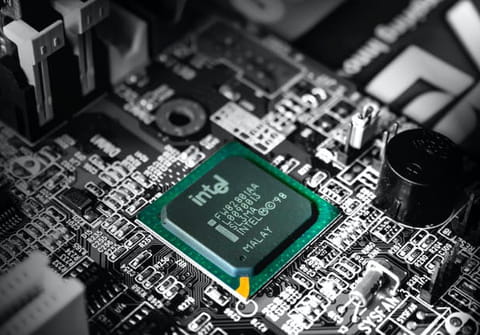Identify the processor: Windows, Mac, Linux

Identifying the processor architecture of your computer system (Windows, Mac, Linux) can be useful to find the configuration and technical capabilities of the PC. This hardware which forms the core of the system can be identified from the system parameters. This article will show you how.
For Windows based systems, the System Properties can either be accessed through the Control Panel or through the Windows Key. There are software utilities available online like CPU-Z that can also do the trick. Under Linux from the /proc file system which enables communication between the 'kernel and the user space', identification of the processor can be done.
How to identify the processor in Windows?
Apart from the possibility of identifying the processor by the system parameters under windows, there are utilities to let you get to know your hardware.
Method 1
-
The simples is to display the properties system.
- Left-click on Menu "Start", left-click on "Control Panel" ... Opening the Control Panel.
- In this window (Panel), a list of icons displayed, and one of these icons, you will find an icon called "System" in which you double-click it.
- The properties are displayed Systems and the first tab is called "General".
- On this tab is the name of your processor, its operating frequency type and its actual incidence.
- Also included in the information below is the total memory (RAM) installed on your computer.
Method 2
- Right click on My Computer (or Computer under Vista) then click Properties.
- Simultaneously press the "Windows" key and "Pause" to open the System Properties window.
With software
Cpu-z, requires no installation. This executable allows you to quickly identify your CPU and gives you its technical characteristics such as the type of operating voltage, the instruction set run, the amount of cache and more information about your motherboard, chipset and memory (RAM).
- Download CPU-Z
- Website of the editor :
For a more complete inventory of your hardware installed:
How to identify the processor in Mac?
For Mac users, identifying your processor is simple. Press the Apple icon in the top left corner of your screen, and select About My Mac.
Your Processor information will then be displayed.
How to identify the processor in Linux?
The /Proc File System
You can type:
cat /proc/cpuinfo
Example:
processor : 0 vendor_id : GenuineIntel cpu family : 6 model : 15 model name : Intel(R) Core(TM)2 CPU 6600 @ 2.40GHz stepping : 6 cpu MHz : 2393.974 cache size : 4096 KB fdiv_bug : no hlt_bug : no f00f_bug : no coma_bug : no fpu : yes fpu_exception : yes cpuid level : 2 wp : yes flags : fpu vme de pse tsc msr mce cx8 apic pge cmov clflush mmx fxsr sse sse2 constant_tsc up monitor bogomips : 4825.12 clflush size : 64
dmesg (Diagnostic the Message)
dmesg | grep CPU
Example:
[ 0.000000] Initializing CPU#0 [ 7.665395] SLUB: Genslabs=22, HWalign=64, Order=0-1, MinObjects=4, CPUs=1, Nodes=1 [ 7.749733] CPU: After generic identify, caps: 0788a3bf 00000000 00000000 00000000 00000008 00000000 00000000 [ 7.750108] CPU: L1 I cache: 32K, L1 D cache: 32K [ 7.750177] CPU: L3 cache: 4096K [ 7.750475] CPU: After all inits, caps: 0788a3bf 00000000 00000000 00000140 00000008 00000000 00000000 [ 8.039007] CPU0: Intel(R) Core(TM)2 CPU 6600 @ 2.40GHz stepping 06 [ 8.157381] Brought up 1 CPUs [ 8.772526] Switched to high resolution mode on CPU 0
dmidecode
The dmidecode command is used to retrieve information about the hardware in your computer by collecting information from the BIOS.
To view information on the processor you must use the following option:
-t, --type TYPE.
For the processor TYPE is 4 (check instructions of dmidecode for details). The command must be run as root.
dmidecode -t 4
Example:
# dmidecode 2.8
SMBIOS 2.2 present.
Handle 0x0004, DMI type 4, 32 bytes
Processor Information
Socket Designation: Socket A
Type: Central Processor
Family: Athlon XP
Manufacturer: AMD
ID: 80 06 00 00 FF FB 83 03
Signature: Family 6, Model 8, Stepping 0
Flags:
FPU (Floating-point unit on-chip)
VME (Virtual mode extension)
DE (Debugging extension)
PSE (Page size extension)
TSC (Time stamp counter)
MSR (Model specific registers)
PAE (Physical address extension)
MCE (Machine check exception)
CX8 (CMPXCHG8 instruction supported)
APIC (On-chip APIC hardware supported)
SEP (Fast system call)
MTRR (Memory type range registers)
PGE (Page global enable)
MCA (Machine check architecture)
CMOV (Conditional move instruction supported)
PAT (Page attribute table)
PSE-36 (36-bit page size extension)
MMX (MMX technology supported)
FXSR (Fast floating-point save and restore)
SSE (Streaming SIMD extensions)
Version: AMD Athlon(tm) XP
Voltage: 1.6 V
External Clock: 133 MHz
Max Speed: 2000 MHz
Current Speed: 1800 MHz
Status: Populated, Enabled
Upgrade: ZIF Socket
L1 Cache Handle: 0x0008
L2 Cache Handle: 0x0009
L3 Cache Handle: No L3 Cache


